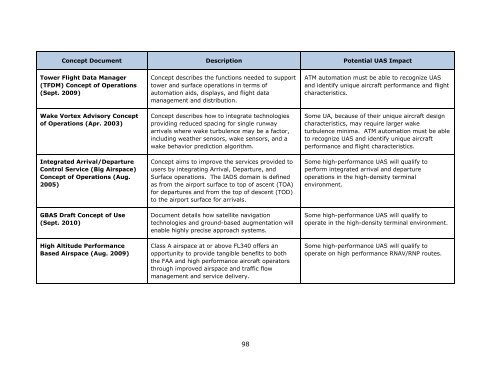FAA-UAS-Conops-Version-2-0-1
FAA-UAS-Conops-Version-2-0-1
FAA-UAS-Conops-Version-2-0-1
You also want an ePaper? Increase the reach of your titles
YUMPU automatically turns print PDFs into web optimized ePapers that Google loves.
Concept Document Description Potential <strong>UAS</strong> Impact<br />
Tower Flight Data Manager<br />
(TFDM) Concept of Operations<br />
(Sept. 2009)<br />
Wake Vortex Advisory Concept<br />
of Operations (Apr. 2003)<br />
Integrated Arrival/Departure<br />
Control Service (Big Airspace)<br />
Concept of Operations (Aug.<br />
2005)<br />
GBAS Draft Concept of Use<br />
(Sept. 2010)<br />
High Altitude Performance<br />
Based Airspace (Aug. 2009)<br />
Concept describes the functions needed to support<br />
tower and surface operations in terms of<br />
automation aids, displays, and flight data<br />
management and distribution.<br />
Concept describes how to integrate technologies<br />
providing reduced spacing for single runway<br />
arrivals where wake turbulence may be a factor,<br />
including weather sensors, wake sensors, and a<br />
wake behavior prediction algorithm.<br />
Concept aims to improve the services provided to<br />
users by integrating Arrival, Departure, and<br />
Surface operations. The IADS domain is defined<br />
as from the airport surface to top of ascent (TOA)<br />
for departures and from the top of descent (TOD)<br />
to the airport surface for arrivals.<br />
Document details how satellite navigation<br />
technologies and ground-based augmentation will<br />
enable highly precise approach systems.<br />
Class A airspace at or above FL340 offers an<br />
opportunity to provide tangible benefits to both<br />
the <strong>FAA</strong> and high performance aircraft operators<br />
through improved airspace and traffic flow<br />
management and service delivery.<br />
98<br />
ATM automation must be able to recognize <strong>UAS</strong><br />
and identify unique aircraft performance and flight<br />
characteristics.<br />
Some UA, because of their unique aircraft design<br />
characteristics, may require larger wake<br />
turbulence minima. ATM automation must be able<br />
to recognize <strong>UAS</strong> and identify unique aircraft<br />
performance and flight characteristics.<br />
Some high-performance <strong>UAS</strong> will qualify to<br />
perform integrated arrival and departure<br />
operations in the high-density terminal<br />
environment.<br />
Some high-performance <strong>UAS</strong> will qualify to<br />
operate in the high-density terminal environment.<br />
Some high-performance <strong>UAS</strong> will qualify to<br />
operate on high performance RNAV/RNP routes.


